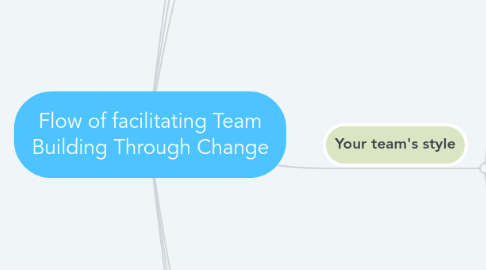
1. Introduction/overview
1.1. Start by introducing yourself
1.1.1. remind them of how you've worked with them
1.1.2. have something ready to say about COVID
1.1.3. Remind them of what you talked about in their individual sessions
1.1.4. Say something about how great they are as a team that they are taking time to really approach the crisis thoughtfully
1.2. Round robin name, role, reference profile, hopes for the session.
1.2.1. Zoom introductions watch your time
1.3. Get the most out of virtual session
1.3.1. Zoom: practice the tools briefly
1.4. Why we are here [team priorities have changed/team members have changed]
1.4.1. Zoom discussion: How has the change in team and/or priorities having an effect on you and the team?
1.5. Team Building Through Change
1.6. The Risks: Team/Operations/Productivity
1.7. Agenda for next 90 minutes
1.8. Pause to surface any questions prior to jumping in - ask for chat questions
2. Close
2.1. Enhance your ability to survive the downturn
2.2. Next Steps
3. Collaborate Through Change
3.1. Frozen team
3.2. Remote Work Guide
4. Your team's style
4.1. Introduce the 4 Team Styles
4.2. Go into the software (circles) to show the team and discuss the following
4.2.1. Show that the team is spread across x number of quadrants - and that's not only OK it's good.
4.2.2. Show the kind of team they are and click on Learn More to describe the team.
4.2.3. DISCUSS: Strengths and blind spots they might have using Zoom and discussion. Start with strengths, then blind spots.
4.3. Overused Strengths
4.4. Leaning on strengths can be effective
4.5. Leaning on strengths can be counter productive
4.6. Discuss: “Have you experienced overused strengths in the past? Are any of you experiencing this during the crisis? Can you share an example?”
4.7. Leaning on Team Strengths
4.7.1. Walk through the example, to demonstrate and prepare for the next activity.
4.7.2. NOTE: Keep the reference profile icons in this section if they help, remove if they are "noise"
4.8. Leaning Too Heavily on Team Strengths
4.9. Tips to increase resilience
4.10. Team Resilience Guide
4.10.1. introduce the guide/remind they have seen this before the session if you choose to send it in advance
4.11. Team Resilience Directions for Breakout sessions
4.11.1. Zoom Breakout Sessions
4.11.1.1. Immediately send a message with link to Resilience Guide and reminder of breakout session tasks
4.11.1.2. ASAP Visit the different breakout rooms to ensure they are on task
4.12. Debrief the breakout session results
5. Concept intro: People and work to be done
5.1. Adapt Team Dynamics Intro
5.2. reference profiles
5.2.1. NOTE: If this helps land the concept, use it, otherwise skim past it or omit the slide.
5.3. two sides of the same coin
5.4. the team doing the work
5.5. the work that needs to be done
5.6. Check for understanding ask for questions - chat or phone
6. Relaunch Your Team
6.1. Talent Misalignment
6.2. Two sides of the same coin: Team doing the work
6.3. Two sides of the same coin: Work to be done
6.4. Objectives aligned to the team
6.4.1. Describe how there are objectives that align with each quadrant, just as there are team styles that align to the quadrants
6.4.2. Describe each type of objective in the quadrants
6.5. Identify the Team Objectives
6.5.1. Go to the software
6.5.1.1. Ask the team to reflect on their review of the Team Objective Checklist prior to the session.
6.5.1.2. Ask them to chat in what they see as the team’s #1 team objective in the wake of the crisis. As you see the Chat feedback coming in from the group, repeat the objectives that are being shared out loud and check them using the in-line software checklist. You are hoping for a maximum of 3 (or at most 4) objectives checked. Or... ask in round robin for verbal choice.
6.5.1.3. Ask participants to describe the level of alignment or gaps displayed comparing team behaviors and team objectives. Ask the team to react this and share their insights on how this resonates with their perceptions of the team.
6.6. Relaunch Blueprint
6.6.1. “Select one top team objectives. For that 1 priority, let’s restate the objective in your own words. What are the specific areas or products in the business that will be involved? What actions will be taken by the team to tackle the initiative? Type in live on-screen both the team objective they decided to focus on and their team-specific initiative in their own words.
6.7. Behavioral Emphasis and Reference Profiles
6.7.1. NOTE: Choose to include or delete based on audience knowledge of reference profiles.
6.8. Special Cases
6.9. Behavioral Emphasis
6.10. Go to the software
6.10.1. toggle to the individual view
6.10.1.1. Choose a team member and describe their data regarding Strong, Moderate, and Low or None areas of behavioral emphasis. Ask that individual to comment on how that resonates. Tell attendees to make note of their strong behavioral emphasis. Ask the group if they have any questions.
6.11. Objectives aligned to the Team
6.11.1. NOTE: This slide in slide show mode will have the buttons that will move you to the correct Relaunch Blueprint with behaviors pre-populated.
6.12. Blueprint
6.12.1. toggle out of slide show mode to write directly on the slide
